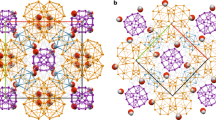Abstract
BECAUSE of the strong long range forces acting between the molecules, molten salts constitute a highly distinctive class of liquids. Up to now, however, the variety of stable ionic melts studied has been largely confined to the simplest ions, such as inert gas type halides, nitrates, and network forming oxides and fluorides. Through the establishment of procedures for achieving chemical stability in molten salts with organic anions1,2, the variety of these ionic melts available for investigation and use is potentially greatly increased. Distinctive microstructures and unusual properties might be expected for at least some of these liquids. We illustrate these possibilities here with new observations on liquid crystals, stable over a wide interval of temperatures, formed by melts of sodium isovalerate and related salts. This group of substances differs in several ways from well known classes of liquid crystals, which include chiefly rod-shaped molecules, with long rigid parts3.
This is a preview of subscription content, access via your institution
Access options
Subscribe to this journal
Receive 51 print issues and online access
$199.00 per year
only $3.90 per issue
Buy this article
- Purchase on Springer Link
- Instant access to full article PDF
Prices may be subject to local taxes which are calculated during checkout
Similar content being viewed by others
References
Hazlewood, F. J., Rhodes, E., and Ubbelohde, A. R., Trans. Faraday Soc., 62, 3101 (1966).
Duruz, J. J., Michels, H. J., and Ubbelohde, A. R., Chem. Indust., 1386 (1969).
Brown, G. H., and Shaw, W. G., Chem. Rev., 57 (6), 1049 (1957).
Gray, G. W., Molecular Structure and Properties of Liquid Crystals 139 (Academic Press, 1962).
Vorländer, D., Ber. dt. Chem. Gess., 43, 3120 (1910).
Vold, R. D., Rosevear, F. B., and Ferguson, R. H., Oil Soap, 16, 48 (1939).
Chatelain, P., Bull. Soc. Franc. Mineral. Cristallog., 60, 280 (1937).
Arnold, H., Demus, D., and Sackmann, H., Z. Phys. Chem., 222, 15 (1963).
Gray, G. W., Molecular Structure and the Properties of Liquid Crystals, 197 (Academic Press, 1962).
Vorländer, D., Trans. Faraday Soc., 29, 902 (1933).
McLaughlin, E., Shakespeare, M. A., and Ubbelohde, A. R., Trans. Faraday Soc., 60, 1184 (1964).
Arnold, H., and Roediger, P., Z. Phys. Chem., 231, 407 (1966).
Arnold, H., Z. Phys. Chem., 226, 146 (1964).
Ubbelohde, A. R., Melting and Crystal Structure (Oxford University Press, 1965).
Author information
Authors and Affiliations
Rights and permissions
About this article
Cite this article
UBBELOHDE, A., MICHELS, H. & DURUZ, J. Liquid Crystals in Molten Salt Systems. Nature 228, 50–52 (1970). https://doi.org/10.1038/228050a0
Received:
Issue Date:
DOI: https://doi.org/10.1038/228050a0
This article is cited by
-
Theories and experimental investigations of the structural and thermotropic mesomorphic phase behaviors of metal carboxylates
Applied Petrochemical Research (2014)
-
Novel types of ionic thermotropic liquid crystals
Nature (1986)
-
A differential thermal analysis study of phase transitions in some mercury(II) carboxylates
Journal of Thermal Analysis (1978)
-
Investigation of the thermal behaviour of fatty acid sodium salts
Journal of Thermal Analysis (1976)
-
Organic Ionic Melts
Nature (1973)
Comments
By submitting a comment you agree to abide by our Terms and Community Guidelines. If you find something abusive or that does not comply with our terms or guidelines please flag it as inappropriate.



